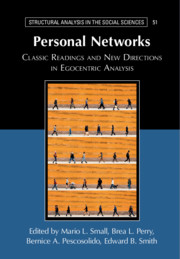Book contents
- Personal Networks
- Structural Analysis in the Social Sciences
- Personal Networks
- Copyright page
- Contents
- Figures
- Tables
- Contributors
- I Background
- II Early Foundations
- III Later Foundations
- IV New Perspectives
- 20 On Cognition
- 21 On Mobilization
- 22 On Trust
- 23 On Dynamics
- 24 On Inequality
- 25 On Culture
- 26 On Migration
- 27 On Movements
- 28 On Social Media
- Index
- Recent Books in the Series
- References
26 - On Migration
Personal Networks and Migration Trajectories
from IV - New Perspectives
Published online by Cambridge University Press: 01 October 2021
- Personal Networks
- Structural Analysis in the Social Sciences
- Personal Networks
- Copyright page
- Contents
- Figures
- Tables
- Contributors
- I Background
- II Early Foundations
- III Later Foundations
- IV New Perspectives
- 20 On Cognition
- 21 On Mobilization
- 22 On Trust
- 23 On Dynamics
- 24 On Inequality
- 25 On Culture
- 26 On Migration
- 27 On Movements
- 28 On Social Media
- Index
- Recent Books in the Series
- References
Summary
Research has long explored the role that networks play in migration and post-migratory adaptation, and a large part of this scholarship uses a personal network approach. This chapter aims to review this literature and critically reflect on its advances and remaining challenges. We first introduce a few key concepts and preliminary methodological considerations for conducting personal network studies in the field of migration. Then, we discuss the empirical evidence in this field. We divide this literature in three broad sections, following its major trends over time: migration flows as network diffusion processes, network effects on individual decision-making and adaptation, and the influence of migration on personal network dynamics. Finally, we argue that research into networks and migration would benefit from a greater sensitivity to temporality, context and the internal heterogeneity of the migrant category, and a firmer knowledge base about personal network dynamics in the general population.
Keywords
- Type
- Chapter
- Information
- Personal NetworksClassic Readings and New Directions in Egocentric Analysis, pp. 675 - 695Publisher: Cambridge University PressPrint publication year: 2021
References
- 2
- Cited by

